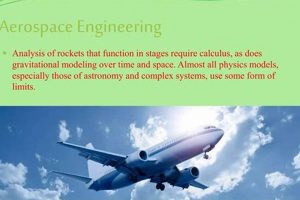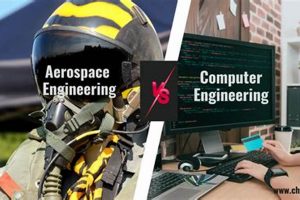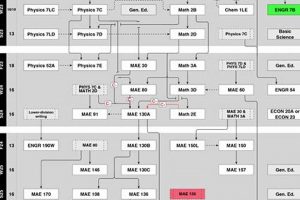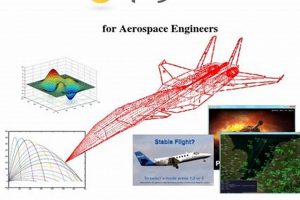The necessary qualifications for entering the field of flight and spacecraft design and development encompass a specific set of educational attainments, skill acquisitions, and personal attributes. These prerequisites establish a foundation for individuals aspiring to contribute to the advancement of aeronautical and astronautical technologies. For example, a strong aptitude in mathematics and physics is fundamental, as is the ability to solve complex problems and work effectively within collaborative teams.
Fulfilling these qualifications is critical for ensuring competence and innovation within the aerospace sector. Meeting standards allows engineers to contribute meaningfully to the design, construction, and testing of aircraft, spacecraft, satellites, and related systems. Historically, these prerequisites have evolved alongside technological advancements in the field, necessitating continuous learning and adaptation for professionals to remain competitive and effective.
The following sections will detail the specific academic credentials, essential skills, and personal characteristics that are vital for achieving success in this demanding and rewarding profession. These aspects are categorized for clarity and further elaboration, offering a roadmap for prospective professionals to navigate their paths toward a career in the aerospace industry.
Guidance for Aspiring Aerospace Engineers
This section offers practical guidance to individuals pursuing a career in aerospace engineering. The advice provided is intended to assist in academic preparation, skill development, and career planning, all essential for success in this competitive field.
Tip 1: Cultivate a Robust Foundation in STEM: Emphasis should be placed on developing a thorough understanding of mathematics, physics, and computer science. A strong grasp of these fundamentals is essential for tackling the complex challenges encountered in aerospace engineering.
Tip 2: Pursue Relevant Academic Credentials: A bachelor’s degree in aerospace engineering is generally the minimum requirement. Consider pursuing advanced degrees (Master’s or Doctorate) for specialized roles or research-oriented positions.
Tip 3: Gain Practical Experience Through Internships: Seek out internships or co-op opportunities with aerospace companies or research institutions. Hands-on experience provides invaluable insights into real-world engineering practices and industry standards.
Tip 4: Develop Proficiency in CAD and Simulation Software: Familiarize yourself with industry-standard computer-aided design (CAD) and simulation software. These tools are integral to the design, analysis, and testing processes in aerospace engineering.
Tip 5: Hone Problem-Solving and Analytical Skills: Aerospace engineering demands strong problem-solving and analytical abilities. Practice tackling complex engineering problems and developing innovative solutions.
Tip 6: Enhance Communication and Teamwork Skills: Effective communication and collaboration are crucial in aerospace projects. Develop the ability to articulate technical concepts clearly and work effectively within multidisciplinary teams.
Tip 7: Stay Updated on Industry Advancements: The aerospace field is constantly evolving. Stay informed about the latest technological advancements, research breakthroughs, and industry trends by attending conferences, reading technical journals, and engaging with professional organizations.
These recommendations emphasize the importance of a well-rounded approach to preparation, encompassing academic excellence, practical experience, and continuous professional development. Adherence to these guidelines will significantly enhance prospects for success in this demanding yet rewarding field.
The subsequent section will summarize the critical attributes and resources discussed, providing a consolidated overview of the pathways toward a fulfilling career in aerospace engineering.
1. Academic qualifications
Academic achievements represent a foundational pillar within the complete framework for prospective aerospace engineers. These credentials provide the essential theoretical grounding and specialized knowledge required to navigate the complex challenges inherent in the field. The degree of academic preparation directly correlates with an individual’s capacity to contribute meaningfully to the design, development, and analysis of aerospace systems.
- Bachelor’s Degree in Aerospace Engineering
This degree provides a broad introduction to fundamental concepts such as aerodynamics, propulsion, structures, and control systems. The curriculum typically includes courses in mathematics, physics, and computer science, which serve as the building blocks for advanced engineering studies. Successfully completing this program demonstrates a baseline competency in the core principles of aerospace engineering.
- Master’s Degree in Aerospace Engineering or a Related Field
A Master’s degree allows for specialization within a specific area of aerospace engineering, such as spacecraft design, computational fluid dynamics, or advanced materials. This advanced training often involves independent research, culminating in a thesis or dissertation. This level of academic achievement demonstrates a deeper understanding of a specific sub-discipline and enhanced research capabilities.
- Doctoral Degree (Ph.D.) in Aerospace Engineering
A Ph.D. represents the highest level of academic attainment in aerospace engineering. It signifies the ability to conduct original research, contribute new knowledge to the field, and lead research teams. Doctoral graduates are often sought after for roles in academia, research institutions, and advanced engineering positions in industry. This achievement validates expertise and independent research capability.
- Relevant Coursework and Specializations
Specific courses, such as those in advanced mathematics, control theory, orbital mechanics, or finite element analysis, further enhance an individual’s qualifications. Completion of specialized coursework demonstrates a targeted understanding of specific areas within aerospace engineering. This detailed knowledge base may make candidates exceptionally attractive for specialized positions within a particular company or industry sector.
In summation, academic certifications are not merely symbolic; they represent a tangible demonstration of foundational knowledge, specialized skill development, and the capacity for innovation, all of which are vital requirements for individuals aiming to excel as aerospace engineers. The depth and breadth of academic pursuits fundamentally shape an engineer’s capabilities and potential for success within this demanding discipline.
2. Technical Skill
Technical skill constitutes a critical component of the overall requirements for becoming an aerospace engineer. Proficiency in specific technical domains directly affects an engineer’s ability to contribute to the design, analysis, and implementation of aerospace systems. Deficiencies in technical skill can impede project progress, compromise safety standards, and limit innovation. The mastery of relevant technical skills is, therefore, not merely desirable, but a fundamental necessity.
The application of CAD/CAM software exemplifies the connection between technical skill and project outcomes. An aerospace engineer adept at utilizing such software can efficiently design complex aircraft components, simulate their performance under various conditions, and optimize their structural integrity. Conversely, an engineer lacking proficiency in these tools may struggle to translate theoretical concepts into practical designs, leading to delays, inaccuracies, and potentially, structural vulnerabilities. Similarly, expertise in computational fluid dynamics (CFD) is vital for analyzing airflow around aircraft and optimizing aerodynamic performance. Without this technical skill, the design of efficient and stable aircraft becomes significantly more challenging. Understanding material science also plays a crucial role in selecting the appropriate alloys and composites for aircraft structures, ensuring durability and minimizing weight.
In conclusion, technical skill is inextricably linked to an aerospace engineer’s effectiveness and impact. The capacity to apply theoretical knowledge through practical technical proficiencies determines an engineer’s ability to contribute meaningfully to the aerospace industry. Continuous development of technical skills is essential for remaining competitive, addressing emerging challenges, and driving innovation within the field. The connection is thus undeniable; a strong foundation of technical skill is a core element of the qualifications, and essential for the prospective aerospace engineer.
3. Problem-solving abilities
Problem-solving abilities are an indispensable facet of the qualifications for an aerospace engineer. This core competency directly influences the capacity to effectively address complex challenges inherent in the design, development, and operation of aerospace systems. Deficiencies in problem-solving skills frequently lead to compromised designs, increased operational risks, and ultimately, system failures.
Consider the hypothetical scenario of an aerospace engineer tasked with designing a new wing structure for a commercial aircraft. This undertaking involves numerous considerations, including aerodynamic efficiency, structural integrity, and weight reduction. During wind tunnel testing, the initial design exhibits unexpected flutter at high speeds. An engineer possessing strong problem-solving abilities would systematically analyze the data, identify the root cause of the flutter (e.g., inadequate stiffness or unfavorable aerodynamic forces), and propose effective solutions such as modifying the wing’s geometry, incorporating damping mechanisms, or adjusting the material composition. The effectiveness of these solutions then requires a comprehensive evaluation of tradeoffs, such as increased weight or cost implications. This analytical and iterative process exemplifies how problem-solving directly shapes outcomes in aerospace engineering. Similarly, when faced with a satellite malfunction in orbit, an aerospace engineer must diagnose the cause of the issue (e.g., a software glitch, a hardware failure, or an external interference), develop a strategy for mitigating the effects of the malfunction, and implement corrective actions through remote commands. In both examples, the capacity to systematically approach complex situations, analyze data, and generate viable solutions is paramount to success.
In summary, problem-solving abilities are not merely a desirable trait but a fundamental skill for aerospace engineers. They enable effective decision-making, promote innovative design, and contribute to the overall safety and reliability of aerospace systems. Cultivating and refining these abilities is therefore a prerequisite for any aspiring aerospace professional.
4. Analytical mindset
An analytical mindset is not merely a desirable attribute, but a fundamental component of the qualifications for an aerospace engineer. The field demands a capacity for rigorous evaluation, critical thinking, and a systematic approach to problem-solving. The absence of a developed analytical mindset can impede the effective assessment of complex systems and compromise the integrity of engineering solutions.
- Data Interpretation and Validation
Aerospace engineers routinely encounter large datasets from simulations, wind tunnel tests, and flight data recorders. The ability to accurately interpret this data, identify trends, and validate its reliability is crucial. For instance, analyzing stress data from a finite element analysis to identify potential points of structural failure in an aircraft wing demands a keen analytical eye. A misinterpretation of data can lead to design flaws with severe consequences.
- System Analysis and Modeling
Aerospace systems are inherently complex, involving numerous interconnected components. An analytical mindset facilitates the creation of accurate system models, enabling engineers to predict system behavior and identify potential vulnerabilities. For example, analyzing the control systems of a spacecraft requires a detailed understanding of feedback loops, sensor inputs, and actuator responses. A lack of analytical rigor in system modeling can lead to instability or performance degradation.
- Risk Assessment and Mitigation
Aerospace projects are inherently high-stakes endeavors, demanding a meticulous approach to risk assessment and mitigation. An analytical mindset enables engineers to identify potential hazards, quantify their likelihood and severity, and develop effective mitigation strategies. For instance, assessing the risks associated with a launch vehicle failure requires a thorough understanding of potential failure modes, their consequences, and the effectiveness of redundancy measures. Inadequate analytical skills in risk assessment can lead to catastrophic outcomes.
- Optimization and Trade-off Analysis
Aerospace engineering often involves optimizing performance parameters while considering various constraints, such as weight, cost, and reliability. An analytical mindset is essential for conducting trade-off studies, evaluating different design options, and selecting the solution that best meets the overall objectives. For example, optimizing the thrust-to-weight ratio of a jet engine involves balancing performance gains against fuel consumption and engine lifespan. A robust analytical approach is crucial for making informed decisions and achieving optimal system performance.
In conclusion, an analytical mindset is a non-negotiable criterion for success in aerospace engineering. It permeates every aspect of the profession, from data analysis to system design to risk management. Developing and refining this essential trait is thus paramount for any individual aspiring to contribute meaningfully to the advancement of aeronautical and astronautical technologies.
5. Communication proficiency
Communication proficiency represents a critical, often underestimated, facet within the extensive qualifications demanded of an aerospace engineer. The capacity to articulate complex technical concepts clearly and concisely, both verbally and in writing, directly influences the efficacy of teamwork, the accuracy of documentation, and the overall success of aerospace projects. Failures in communication can lead to misunderstandings, errors, and potentially, catastrophic consequences in this high-stakes environment.
The intricate nature of aerospace engineering necessitates seamless collaboration among diverse teams comprising engineers from various disciplines, technicians, project managers, and regulatory bodies. Effective communication serves as the conduit through which these individuals share information, coordinate tasks, and resolve conflicts. For example, an aerospace engineer tasked with designing a new aircraft wing must communicate design specifications, performance requirements, and safety considerations to the manufacturing team, ensuring that the wing is built according to the intended design. The clarity and accuracy of this communication directly affect the quality and reliability of the final product. Similarly, when troubleshooting a satellite malfunction, engineers must communicate diagnostic findings, proposed solutions, and operational procedures to ground control personnel, enabling timely and effective corrective actions. This continuous flow of information is essential for maintaining the integrity and functionality of the satellite system. Furthermore, communication proficiency extends to the creation of comprehensive technical documentation, including design reports, test plans, and maintenance manuals. These documents serve as vital resources for engineers, technicians, and operators throughout the lifecycle of aerospace systems.
In summary, communication proficiency is an indispensable element of the qualifications for an aerospace engineer. It facilitates effective teamwork, ensures the accuracy of technical documentation, and promotes the overall safety and reliability of aerospace systems. Cultivating strong communication skills is thus a crucial investment for any aspiring aerospace professional. The inability to convey information accurately and efficiently poses a significant challenge, potentially undermining even the most technically sound engineering designs and analyses. Addressing this aspect of professional development is, therefore, essential for ensuring success in this demanding field.
6. Ethical responsibility
Ethical conduct forms a fundamental, yet often tacit, qualification for individuals seeking to enter the field of aerospace engineering. Beyond the technical skills and academic achievements, a strong moral compass guides decision-making processes that can have profound societal implications. This responsibility permeates all aspects of the profession, from design and development to testing and implementation.
- Safety and Public Welfare
Aerospace engineers bear a significant responsibility for ensuring the safety of the public. Design choices, material selection, and testing protocols directly impact the lives of passengers, crew, and individuals on the ground. An ethical engineer prioritizes safety above all else, adhering to rigorous standards and erring on the side of caution, even when faced with budgetary constraints or tight deadlines. Real-world examples, such as the investigation of aircraft accidents, often reveal the critical role that ethical decision-making plays in preventing future tragedies. Failure to uphold these ethical standards can lead to catastrophic consequences, eroding public trust and damaging the reputation of the profession.
- Honesty and Integrity in Research
Aerospace research relies on the accuracy and integrity of data. Ethical engineers are committed to honest data collection, analysis, and reporting, avoiding any form of fabrication, falsification, or plagiarism. The manipulation of research data can have far-reaching implications, leading to flawed designs, inaccurate performance predictions, and ultimately, unsafe products. Upholding ethical standards in research is crucial for maintaining the credibility of the aerospace engineering community and fostering innovation based on sound scientific principles.
- Environmental Stewardship
The aerospace industry has a significant environmental footprint, contributing to air and noise pollution, as well as the depletion of natural resources. Ethical engineers strive to minimize the environmental impact of their work, developing sustainable technologies and practices. This includes designing more fuel-efficient aircraft, reducing emissions, and promoting the use of environmentally friendly materials. Embracing environmental responsibility is not only ethically sound but also essential for ensuring the long-term sustainability of the aerospace industry and mitigating its impact on the planet.
- Conflict of Interest Avoidance
Aerospace engineers often encounter situations where personal interests may conflict with their professional obligations. Ethical engineers are vigilant in identifying and avoiding such conflicts, disclosing any potential biases that could compromise their judgment. For example, an engineer evaluating a proposal from a company in which they have a financial stake must recuse themselves from the decision-making process to ensure impartiality. Maintaining objectivity and transparency is crucial for upholding the integrity of the profession and avoiding any appearance of impropriety.
These facets illustrate that ethical conduct is not merely an addendum, but an integral part of the overall skill set and mindset expected of an aerospace engineer. Incorporating ethical considerations into the educational curriculum, professional development programs, and organizational culture is vital for fostering a workforce that prioritizes safety, integrity, and sustainability. The qualifications for a successful aerospace engineer, therefore, extend beyond technical expertise to encompass a deep commitment to ethical responsibility.
Frequently Asked Questions Regarding Qualifications for Aerospace Engineering
The following section addresses common inquiries and concerns regarding the credentials and attributes essential for a career in aerospace engineering. The information presented is intended to provide clarity and guidance to aspiring professionals in this field.
Question 1: Is a specific undergraduate degree mandatory for pursuing a career in aerospace engineering?
While a Bachelor of Science in Aerospace Engineering is the most direct route, degrees in related fields such as Mechanical Engineering, Electrical Engineering, or Physics can also provide a foundation for entry, often requiring subsequent specialized training or a Master’s degree in Aerospace Engineering.
Question 2: What level of mathematical proficiency is deemed necessary?
A strong foundation in calculus, differential equations, linear algebra, and numerical methods is indispensable. These mathematical tools form the basis for analyzing and modeling complex aerospace systems.
Question 3: Are internships essential for gaining practical experience?
Internships or co-op experiences provide invaluable hands-on experience, allowing students to apply theoretical knowledge to real-world engineering problems and gain exposure to industry practices. These experiences are highly valued by employers.
Question 4: What software skills are most beneficial to develop?
Proficiency in industry-standard computer-aided design (CAD) software, simulation tools, and programming languages (e.g., MATLAB, Python) is highly advantageous. These tools are integral to the design, analysis, and testing of aerospace systems.
Question 5: How important are communication and teamwork skills?
Effective communication and collaboration are crucial in aerospace projects, which often involve multidisciplinary teams. The ability to articulate technical concepts clearly and work effectively with others is essential for success.
Question 6: What role does ethical conduct play in aerospace engineering?
Ethical considerations are paramount due to the potential impact of aerospace systems on public safety and the environment. Adherence to ethical principles is essential for ensuring the responsible development and deployment of aerospace technologies.
In conclusion, achieving a career in aerospace engineering requires a multifaceted approach, encompassing academic excellence, technical proficiency, practical experience, strong communication skills, and a commitment to ethical conduct.
The next section summarizes the pathways to a successful and enduring career in this field.
Requirements to Become an Aerospace Engineer
This exploration has elucidated the multifaceted nature of what constitutes the qualifications to become an aerospace engineer. Beyond the attainment of a relevant academic degree, the necessity for technical proficiency, robust problem-solving capabilities, an analytical mindset, adept communication skills, and unwavering ethical responsibility has been thoroughly established. These elements, acting in concert, form the foundation upon which a successful and impactful career in the aerospace sector is constructed.
The pursuit of a profession within the aerospace domain demands a sustained commitment to intellectual rigor, practical application, and ethical conduct. Prospective engineers must recognize that meeting the requirements to become an aerospace engineer is not merely a checklist of accomplishments, but an ongoing process of learning, adaptation, and dedication to advancing the boundaries of aeronautical and astronautical knowledge for the betterment of society.







